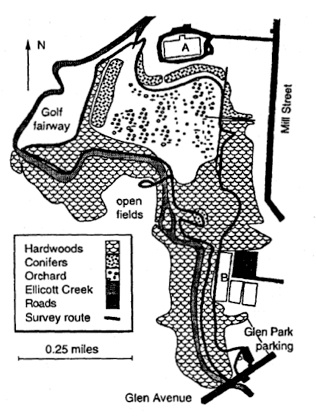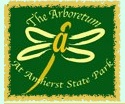Please use the navigation menu at bottom the Page
MenuGoHere
favicongohere


The Birds of Amherst State Park
We pick out a Philadelphia Vireo and a late Solitary Vireo as well. A Brown Thrasher sings ahead along the forest margin. Following the fence we soon come to the open meadow and abandoned orchard to our left. But before we squeeze through a broken place we check at the top of the rise to our right the backyard feeders of several houses. We're lucky today: a Tufted Titmouse and a Pine Siskin are among the birds at the trays. As we emerge into the wet meadow we're met with the chatter of a House Wren and from the orchard beyond an Eastern Bluebird calls. The beauty of the apple blossoms is enhanced by their contrast with the gnarled limbs of these old and dying trees. There are only Yellow Warblers on this side of the orchard, so we move on to the sidewalk below the White Pines. All this is private property but the Sisters and their groundskeepers have always been accommodating to birders. Above us in the tall trees are Red-breasted
Nuthatch and more chickadees; several Blackburnian Warbler and Chipping Sparrow sing from the highest perches. Chimney Swift circle the mother house. At the far end of the sidewalk formal gardens reach down to the creek bank. Here in this dark area are more juncos and a Lincoln's Sparrow. A Scarlet Tanager rasps downstream. We are at the northern end of our route where we cross a footbridge to the creek edge. So far our list includes only a few warbler species; on the way back we'll find many more. But now across the creek we find a Spotted Sandpiper exploring the mud and a pair of unwelcome Canada Geese march above it along the edge of the golf fairway. An early Mallard brood plies the eddies and a Belted Kingfisher speeds by, rattling as it goes. Tree and Barn Swallows fly overhead and a towhee chinks from a willow. We wade through tall wet grass to an area of mixed hardwoods behind a thick pine grove and immediately begin to add warblers to our list. Wilson's first, then Canada and a Common Yellowthroat, all these yellow-bellied birds within twenty yards. From here on we'll find warblers in small mixed flocks. Sadly there will be only one or two of each species. Once in late April I even found a group of warblers feeding on the manicured golf course lawn that now separates us from the creek. When we reach the end of the fairway at a golfers' bridge, we pause to pick up the songs of Ovenbird and Carolina Wren and to watch Yellow Warbler and American Redstart cavort in the low bushes. Entering the woods again we find a nice group: some late Yellow-rumped and a Palm Warbler together with Black-throated Blue, Black-throated Green, Blackand-white, Nashville, and Tennessee Warblers. A few Blackpoll Warbler and an Indigo Bunting tell us that the spring migration is nearing its end. Chestnut-sided and more Magnolia Warblers appear in the next group along the creek. Here we also find Bay-breasted and Cape May Warblers. In the thickets and apple trees at the bridge we find our last group, adding singing Northern Parula and Blue-winged Warblers to complete our total of 22 warbler species. But we pick up a few additional species in the woods ahead. Both kinglets join a number of warblers in the pine grove only recently deserted by the horned owl. Several Least Flycatcher start calling now and a pair of Red-headed Woodpecker dash from tree to tree along the stream. And when we emerge again at the Glen Avenue bridge we find Northern Rough-winged Swallow on the wires with the ever present Rock Dove. An Eastern Phoebe joins the crowd.
Table 1. Williamsville Glen spring census totals.
1989 1990 1991 1992
WARBLERS
Maximum species/day 18 23 22 13
May date of maximum 19 21 12 18
Season species total 25 24 27 20
ALL BIRDS
Maximum species/day 63 72 73 49
May date of maximum 16 21 12 13
Season species total 94 102 107 88
The walk I have described represents a big day like those of 1990 and 1991. Over the four years of spring censuses in the Glen, 133 species have been identified including 30 warbler species. In addition to those mentioned above, Golden-winged, Pine, Cerulean, Worm-eating, Kentucky, Connecticut, Mourning, and Hooded Warblers have been seen as well as the Brewster's type of Blue-wing x Golden-wing hybrid. The overall species count is low because only a few non-passerine species, and almost no water birds, have been found. Table 1 summarizes the census results for the four years they have been conducted by the Buffalo Ornithological Society and suggests the range of dates of peak activity.
Less is known about the birds of the Williamsville Glen in other seasons. Investigations of summer residents, of autumn migrants, and of wintering species all would be worthwhile. Birders interested in visiting the Glen in April and May should plan to contribute their records to this author. Anyone who would like company on a trip there at any time of year is also welcome to contact me.
THE WILLIAMSVILLE GLEN:
A SUBURBAN SPRING MIGRANT TRAP
Gerald R. Rising
The Kingbird 1994 Vol. 44 No. 1: pages 18-22


My first visit to the Williamsville Glen in this Buffalo suburb was on a Saturday morning in May 1987. Following a path into the woods just northeast of the Glen Avenue bridge, I came immediately upon a wrinkled three inch square piece of paper impaled on the branch of a shrub. On it was printed the cryptic note: "Seen here Thursday." A few yards further along appeared the sequel: "Under bushes ahead Friday." As I read the second message, I noticed in those very bushes two birders fussing over a tape recorder. One of them, Bruce Chilton, informed me that Peter Yoerg's notes referred to a Swainson's Warbler that Peter had discovered there earlier in the week. Others had confirmed Peter's remarkable find, but none of us found the elusive skulker that day. Despite that, on that windy May morning I had found a birding "home."
The Williamsville Glen is an extension of Williamsville's Glen Park. It extends north from Glen Avenue for about a mile between Ellicott Creek to the west and the backs of residential properties along Mill Street to the east. The more formal sections of Glen Park are mostly south of Glen Avenue where there is an attractive cascade in the creek. Although this section is usually overrun by families feeding the tame Mallards (contrary to park rules), its shrubbery is worth an check early in the day before the crowd arrives.
This glen is essentially a spring migrant trap. Why is an open question. It lies in a populous suburb immediately northeast of the City of Buffalo: The village of Williamsville is a part of Amherst, a town whose population ranks it sixth of the state's metropolitan districts, ahead of Albany and Binghamton, for example. Glen Avenue is just one block north of shop-lined Main Street, a major traffic artery that extends out from Buffalo and continues as Route 5 toward Batavia.
The easternmost end of Lake Erie is about fifteen miles to the south-southwest, and the northerly flow of spring migrants that is forced northeast along the shore of that lake probably turns north again when it reaches this point. Although we know that many migrants continue along the shore to Buffalo's Tifft Nature Preserve, Forest Lawn Cemetery, and Delaware Park and then on along the Niagara River, others may drift slightly to the east to avoid the central city, Such birds may then drop into the Glen.
Figure 1. Williamsville Glen. The letter A denotes the St. Francis Motherhouse of St. Mary of the Angels (private), and the letter B denotes the Village Glen Tennis and Fitness Club.
Perhaps, but the Glen is not an island in a city sea like New York's Central Park. On all sides are residential streets lined with mature trees in which small groups of migrants are also to be found. Nor do geologic features funnel in birds; in particular creeks, including Ellicott Creek south of the Glen, generally run east to west across the northward flow of migrating birds.
Birdwatchers can reach the Glen more easily. From the Main Street East exit of I-290, drive east just over a mile. Take two lefts: north on Mill Street and west on Glen Avenue a few yards to the parking lot on your right. Once there the accompanying map (Fig. 1) shows a walk that Buffalo Ornithological Society members have followed to census migrants on about twenty days each spring since 1989. Join me on one of those mid May mornings at the peak of migration to see what is to be found along that two and a half mile route.
The apple trees and ornamental shrubs around the parking lot produce House Finches, blackbirds, a Gray Catbird, Song, Whitecrowned and White-throated Sparrows, Dark-eyed Junco, and Yellow Warbler. A Northern Oriole and a Warbling Vireo alternate songs from high in the trees along the creek and a Wood Thrush carols in the distance. We enter the woods at the end of the lawn and immediately find ourselves in a wilder area. The hardwoods here are very tall and the understory sparse, so the birds here are to be seen at a distance. We quickly add White-breasted Nuthatch, Black-capped Chickadee, Redeyed Vireo, Northern Cardinal, Eastern Wood-Pewee, American Redstart, and Black-and-white and Magnolia Warblers to our list. The subdued sounds of dance music greet us at the Tennis Club, in which early morning exercisers cavort. Among the shrubs behind the building are two Veery and a rarer Gray-cheeked Thrush. Rose-breasted Grosbeak and several of the common woodpecker species are to be seen in the canopy above. Just beyond this building we enter a low swampy area with old overgrown orchard trees still holding out against the taller cottonwoods. Here a Northern Waterthrush greets us. American Crow and Blue Jay noisily chase a Great Horned Owl out of the pine grove to our left. A Great Crested Flycatcher wheeps. As the taller trees take over again, we clamber over a ten foot ridge and see the twisted remains of an iron picket fence ahead.








